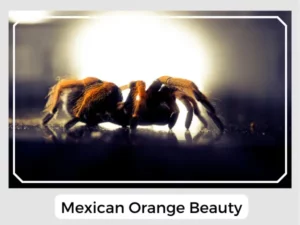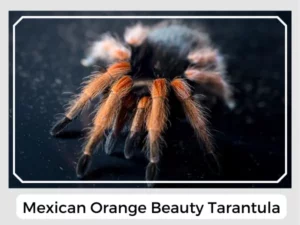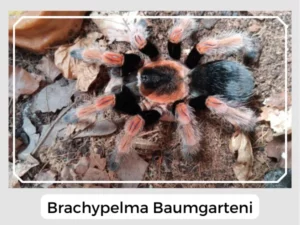The Mexican orange beauty tarantula is a special spider from Mexico. It looks a bit like the Mexican pink tarantula but is more like the Mexican fireleg tarantula on the inside. Get ready, because we’re about to share some cool facts about this fascinating creature!

Photo Credit: Richard Eldon

Photo Credit: Richard Eldon
The eggs of this tarantula are yellow, which the mother immediately covers with a sac of webbing.
Initially, the spiderlings have a transparent white abdomen before molting to resemble the adults.
Like other tarantulas, these spiders do not construct webs to capture prey.
Yes, Mexican Orange Beauty Tarantulas have venom. But for most people, their bite is like a bee sting. Their venom is mild and not fatal to humans.
Absolutely, they can bite. It’s their way to defend themselves if they feel threatened. But they usually prefer to avoid conflict if possible.
The behavior of the Mexican orange beauty tarantula is both fascinating and beneficial to the environment. Primarily nocturnal, these spiders are solitary creatures, emerging at night to hunt for prey. Their presence in the ecosystem is vital as they help control the populations of insects and other small animals, ensuring a balance in the food web.
Natural Predators: Despite their daunting appearance and venomous bite, the Mexican orange beauty tarantula is not without its natural threats. Predators such as birds of prey, larger mammals, and even other species of spiders are known to hunt these tarantulas. Their natural defense mechanisms, such as their urticating bristles, which they can release when threatened, offer some protection. However, they are not always enough to deter a determined predator.
Prey-Predator Dynamics: The prey-predator dynamics of the Mexican orange beauty tarantula are a testament to the intricate food webs in tropical forests. Their diet primarily consists of insects like cockroaches, crickets, and locusts. These spiders play a crucial role in managing the populations of these insects, which, if left unchecked, could cause significant damage to the forest vegetation. The tarantula’s hunting strategy is one of patience and precision, utilizing ambush rather than the creation of webs to capture their prey.
Relationship with Humans: The relationship between the Mexican orange beauty tarantula and humans is complex. While they are often feared due to their venomous bite and imposing appearance, they are not aggressive towards humans and will only bite if provoked. In recent years, these spiders have gained popularity in the pet trade due to their remarkable coloration and relatively docile nature. However, it is crucial for potential keepers to understand the responsibility that comes with caring for such a creature, including habitat preservation and the avoidance of wild-caught specimens to protect their natural populations.

Photo Credit: Takeshi Mekaru
| Lifespan | Males: 6 years, Females: 20-40 years |
| Distribution | The Pacific coast of Michoacán, Mexico, ranging from Sierra Madre del Sur in the north to Balsas River in the east |
| Habitat | Tropical forests |
| Diet | Cockroaches, crickets, and locusts |
In conclusion, the Mexican orange beauty tarantula is more than just a beautiful specimen; it is an integral part of its ecosystem.
The Mexican orange beauty tarantula is a special spider from Mexico. It looks a bit like the Mexican pink tarantula but is more like the Mexican fireleg tarantula on the inside. Get ready, because we’re about to share some cool facts about this fascinating creature!

Photo Credit: Richard Eldon

Photo Credit: Richard Eldon
The eggs of this tarantula are yellow, which the mother immediately covers with a sac of webbing.
Initially, the spiderlings have a transparent white abdomen before molting to resemble the adults.
Like other tarantulas, these spiders do not construct webs to capture prey.
Yes, Mexican Orange Beauty Tarantulas have venom. But for most people, their bite is like a bee sting. Their venom is mild and not fatal to humans.
Absolutely, they can bite. It’s their way to defend themselves if they feel threatened. But they usually prefer to avoid conflict if possible.
The behavior of the Mexican orange beauty tarantula is both fascinating and beneficial to the environment. Primarily nocturnal, these spiders are solitary creatures, emerging at night to hunt for prey. Their presence in the ecosystem is vital as they help control the populations of insects and other small animals, ensuring a balance in the food web.
Natural Predators: Despite their daunting appearance and venomous bite, the Mexican orange beauty tarantula is not without its natural threats. Predators such as birds of prey, larger mammals, and even other species of spiders are known to hunt these tarantulas. Their natural defense mechanisms, such as their urticating bristles, which they can release when threatened, offer some protection. However, they are not always enough to deter a determined predator.
Prey-Predator Dynamics: The prey-predator dynamics of the Mexican orange beauty tarantula are a testament to the intricate food webs in tropical forests. Their diet primarily consists of insects like cockroaches, crickets, and locusts. These spiders play a crucial role in managing the populations of these insects, which, if left unchecked, could cause significant damage to the forest vegetation. The tarantula’s hunting strategy is one of patience and precision, utilizing ambush rather than the creation of webs to capture their prey.
Relationship with Humans: The relationship between the Mexican orange beauty tarantula and humans is complex. While they are often feared due to their venomous bite and imposing appearance, they are not aggressive towards humans and will only bite if provoked. In recent years, these spiders have gained popularity in the pet trade due to their remarkable coloration and relatively docile nature. However, it is crucial for potential keepers to understand the responsibility that comes with caring for such a creature, including habitat preservation and the avoidance of wild-caught specimens to protect their natural populations.

Photo Credit: Takeshi Mekaru
| Lifespan | Males: 6 years, Females: 20-40 years |
| Distribution | The Pacific coast of Michoacán, Mexico, ranging from Sierra Madre del Sur in the north to Balsas River in the east |
| Habitat | Tropical forests |
| Diet | Cockroaches, crickets, and locusts |
In conclusion, the Mexican orange beauty tarantula is more than just a beautiful specimen; it is an integral part of its ecosystem.